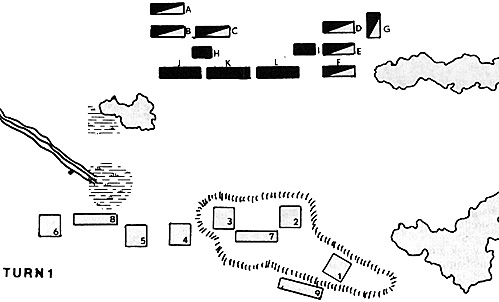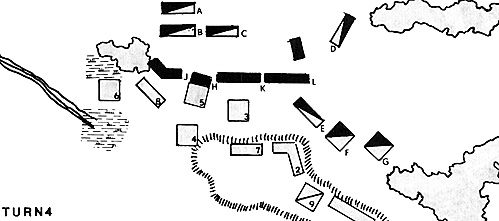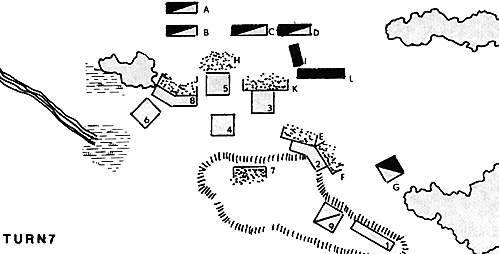This was an encounter between two 1250 point armies. The armies drawn from the lists, were as follows:
| SCOTS | ENGLISH |
|---|---|
| General & Subgeneral 150 pts | General & Subgeneral 150 pts |
| 1,2,3,mixed 6 EHI & 16MI 489 | A,B,C,6 EHC 387 pts |
| 4,5,6, mixed 6 HI & 18 MI 399 | D,E,F, HC 291 pts |
| 7 Highlanders 10 A class LMI 95 pts | G Border horses LC 50 pts |
| 8 Highlanders 10 C class LMI 65 pts | H,I 12 HI 164pts |
| 9 Border horses 5 LC 60 pts | J,K,L 20 LMI archers 210 pts |
| 1248 pts | 1252 pts |
The Scots took a strong defensive position, extending in a line from the hill to the small stream on their left flank, with the schiltrons spaced evenly along the line. This provided them with relatively secure flanks anchored by the woods and swamps. This proved very useful in that they were outscouted. The English deployment had the archers in great strength across their front, acting as a screen for the army, with the balance of the infantry for their immediate support and the cavalry to the rear.
The initial moves saw a general advance by the English across their entire front, so as to increase the effectiveness of their longbows. The effect of the concentrated fire of the longbows was the uncontrolled advance of one of the schiltrons (5). The English advance continued until it reached its predetermined position. There the archers were to hold in preparation for the cavalry launching their attacks on the hoped for isolated and disorganized Scots schiltrons.
However before the attack orders could be given to the cavalry, the English commander-in-chief was killed by the archery fire of the highlanders (7) positioned on the hill. This unfortunate occurance brought to a halt the complete right wing of the English army. At the same time the Scots commander had launched his left wing units in an attack in support nf the uncontrolled schiltron.
On the English left wing the sub-commander was quickly sending his cavalry to attack the Scots on the hill. This was an attempt to gain time while he corrected the orders of the now leaderless right wing. The results of these moves was the rout of the unsupported archers (J & K) and their heavy infantry support (H) on the right wing (the support cavalry was still on hold orders), and the rout of the heavy cavalry (E & F) on the left wing.
Their attack on the schiltrons on the hill had been repulsed after only marginal success; they had managed to break the unit of highlanders (7). It was at this point that two of the units of knights (A & B) retired from the battle. These were quickly followed by the remaining archer unit (L) and then by the complete withdrawal of the whole army, the sub-commander last seen muttering under his breath of original orders and incompetence.
In the battle the Scots had given all of the initial advantage to the English because of their defensive position and their hold orders; however they were quick to capitalize on the advantage gained with the death of the
English commander and the resulting loss of orders and co-ordination of movement. To compensate the English had been forced to throw their unsupported cavalry against the schiltrons, with their resulting losses, if they were to have had any chance of salvaging the game.
A partial list of figures available for the period is as follows:
25mm - Grenadier medieval chivalry; Garrison medieval; Scruby crusaders and medieval; Hinchliffe medievals; Heritage chivalry; Ral Partha 1200 AD range; Dixon medievals; Lamming medievals; Miniature Figurines Hundred Years War & Was of Roses.
15mm - Peter Laing medievals; Mikes Models medievals; Miniature Figurines medievals.



Back to Table of Contents -- Courier Vol. 2 #6
To Courier List of Issues
To MagWeb Master Magazine List
© Copyright 1981 by The Courier Publishing Company.
This article appears in MagWeb (Magazine Web) on the Internet World Wide Web.
Other military history articles and gaming articles are available at http://www.magweb.com